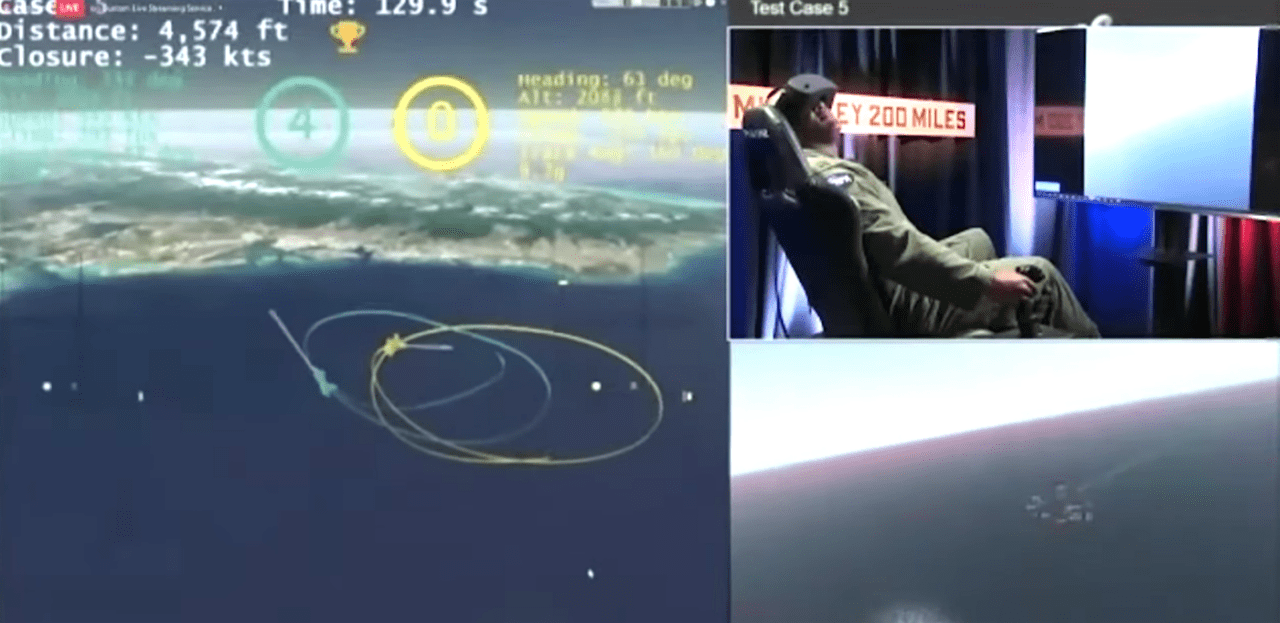
Heron Systems Inc. defeated an F-16 weapons instructor during the conclusion of DARPA’s Alpha Dog fighter AI competition on Aug. 21. (DARPA)
Heron Systems was declared the winner of the Defense Advanced Research Projects Agency (DARPA) AlphaDogfight trials between artificial intelligence (AI)-enabled F-16 simulators and U.S. Air Force, Navy, and Marine Corps pilots that took place Friday, Aug. 21, after being delayed due to the COVID-19 pandemic.
The finals were to occur at AFWERX headquarters in Las Vegas in Las Vegas with fighter pilots from the Air Force Weapons School at Nellis AFB, Nev., until COVID-19 made the virtual competition necessary, said Air Force Col. Dan “Animal” Javorsek, the program manager of Air Combat Evolution in DARPA’s Strategic Technology Office.
The Air Force picked eight teams to compete last year to show advanced AI algorithms to permit autonomous F-16 dogfighting, and Javorsek said in a statement that “it’s been amazing to see how far the teams have advanced AI for autonomous dogfighting in less than a year.”
The teams selected were Boeing‘s Aurora Flight Sciences, Lockheed Martin, Perspecta Labs, EpiSys Science, Inc., Heron Systems, PhysicsAI, SoarTech, and the Georgia Tech Research Institute.
Heron, a small business of 30 employees with locations in California, Maryland and Virginia developed AI algorithms for a simulated F-16 Viper fighter jet that defeated one of the U.S. Air Force’s most experienced F-16 weapons instructors, a pilot with the call sign Banger.
Heron’s AI was able to win all five rounds against Banger, in rounds where the simulated battles were restricted to the use of the nose cannon only.
During a live YouTube question and answer session, Benjamin Bell, a senior machine learning engineer at Heron Systems, Inc., said that he believed one of the advantages of their AI agent was the way they configured its neural network combat learning capabilities.
“Our advantages were that we were only using reinforcement learning, so we tried to create an action scheme where the neural network can control the plane in a way that is both smooth, which you didn’t see our competitors doing, but also at a high enough rate that we’re able to make some of those high aspect shots and keep that machine level targeting of our opponents,” Bell said.
“We were trying to create smooth output so that we’re not spazzing on the control and controlling around 10 hertz actually, most of our competitors seemed like they were controlling at around 50 hertz, and one of the nice parts is it helps the agent to be certain. If it is limited in controlling the plane, then when it lines up for the plane it has to know that the trajectory from now until the next three seconds is going to keep its opponent in that one degree cone and win the game,” he added.
Justin “Glock Mock,” an Air Force weapons school graduate who co-hosted the virtual event with DARPA, described the AI targeting capabilities provided by Heron Systems as “superhuman,” while cautioning that the simulation was still a far cry from going out and doing real F-16 combat training. One of the major differences, for example was that Heron’s AI agent has perfect state information about both machines, which is something that never happens in actual theater.
Javorsek said that “regardless of whether the human or machine wins the final dogfight, the AlphaDogfight trials is all about increasing trust in AI.”
“If the champion AI earns the respect of an F-16 pilot, we’ll have come one step closer to achieving effective human-machine teaming in air combat, which is the goal of the ACE program,” he said.
Air Combat Commander Gen. James “Mobile” Holmes said that he was monitoring the trials all last week. “I’m all in for the test,” he said, adding that his notion is to try such AI dogfighting first in “Red” adversary aggressor squadrons against manned aircraft. Holmes said that AI would initially provide options for pilots and human operators of command and control systems before moving to full control of a platform, akin to the trend for self-driving cars.
Holmes said that the move to privatize Air Force aggressor squadron training will free up Flight Training Unit (FTU) commanders and fighter pilots who previously had to devote time to aggressor squadron “red teaming,” rather than their own training.
Last month, the Air Force awarded its first aggressor squadron contracts to Textron’s Airborne Tactical Advantage Company (ATAC) – a $240 million contract for operations at Luke AFB, Ariz., and Holloman AFB, N.M., Tactical Air Support, Inc. a $90.4 million contract for training at Kingsley Field, Ontario, and Draken International – a $74.5 million award to support training at Kelly Field, Texas and Seymour Johnson AFB, N.C.
ATAC said that it plans – to use its fleet of Dassault Mirage F1 fighters to provide more than 3,000 aggressor sorties per year for up to four and a half years.
While freeing up pilots, contracting out aggressor squadron training could cost the Air Force $400 million per year, according to Privatized Adversary Air Combat Training, a report this month by Jeremiah Gertler, a military aviation analyst with the Congressional Research Service.
“A broader issue is whether military training should be considered an inherently governmental function, part of a long-standing debate on privatization that government has addressed previously but is also currently evident in areas such as air-to-air refueling services and logistics support for military aircraft,” per the report. “In possible counterpoint to the contract adversary air movement, the report accompanying the Fiscal 2020 National Defense Authorization Act included language requiring the Air Force to report on the costs and schedule for expanding its in-house aggressor fleet.”